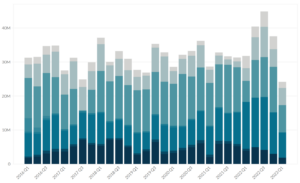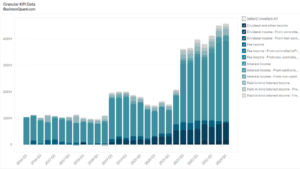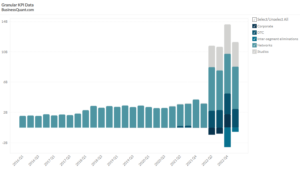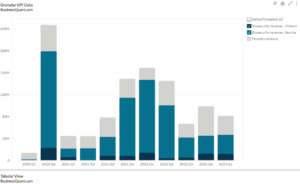
Digital Realty Trust’s Revenue Breakdown (2016-2023)
Exclusive Data
You need the Pro Plan to access KPI data
- Full access to the platform
- KPI data & segment financials on US stocks
- Financial data on thousands of stocks
- Download data in xlsx and csv formats
Pro Plan
$49 per month*
60% discount ends in:
.
About
More information
Subscribe to Pro or Enterprise plans to unlock this feature.
Contact the Analyst
Subscribe to Pro or Enterprise plans to unlock this feature.
Become a smarter investor today.
Access KPIs & Segment Financials on US stocks
This statistic highlights Digital Realty Trust’s Revenue Breakdown, split between Fee income and others and Rental and other services, reported quarterly from Q1 2016 onwards.
Digital Realty Trust’s Revenue Breakdown
The Major Portion of the Digital Realty Trust Revenue Breakdown is as follows:
| Segment | 2022 Q3 | 2022 Q4 | 2023 Q1 | Contribution in 2023 Q1 |
| Fee income and other | 7.90 | 7.70 | 8.80 | 0.65% |
| Rental and other services | 1,184.20 | 1,225.40 | 1,330.00 | 99.35% |
| Total | 1,192.10 | 1,233.10 | 1,338.70 | 100% |
(Note: Above all figures are in millions except percentages)
As per the above data, Fee income and other in 2022 Q4 was $7.7 million which rises in 2023 Q1 by $1.1 million. The contribution of Fee income and others was 0.65% in 2023 Q1, covering the small income stream of the Digital Realty Trust. The crucial income of the Digital Realty Trust came from Rental and other services. It contributes 99.35% income stream. It was $1184.2 million in 2022 Q3 and rise in 2022 Q4 by $41 million. DLR raised 8.48% from 2022 Q4 to 2023 Q1 was $1330 million.
Revenue by Business Vertical or Revenue Breakdown
Revenue breakdown refers to the total income earned from its different lines of business or industry segments. A business vertical represents a specific sector, market, or product/service category within the operations. Revenue breakdown provides an understanding of the relative profitability and the growth potential of different parts of the business. This information helps stakeholders, including investors, analysts, and management.
For example, Digital Realty Trust having multiple revenue breakdowns has revenue streams coming from Fee income and other Rental and other services. By examining revenue by business vertical, the company can assess the performance of each vertical individually. It also makes informed decisions regarding resource allocation, strategic planning, and investment priorities. Revenue by business vertical is generally presented in financial reports, where companies may provide a breakdown of their total revenue by segment.
Fee Income and Others
Fee income generally refers to the revenue earned from providing specific services for a fee. In the context of a real estate investment trust, fee income comes from various sources, such as Property management, development, asset management, and other services fees. REITs generally earn income by providing property management services to the property’s owner. It may include leasing, maintenance, tenant services, and other related activities. Additionally, if the REIT is involved in real estate development projects, it may earn fee income by providing development services to third parties or joint venture partners. REITs may also charge fees for managing the assets of other real estate investors or for managing investment funds focused on real estate. REITs may offer additional services, such as consulting, advisory, or brokerage services, and earn fees from those activities.
Other income generally refers to income not generated from the primary business activities. In the case of a real estate investment trust, examples of other income sources include interest income, gain on the sale of property, rental income from non-core properties, and dividend income. REITs earn interest on cash and cash equivalents held in their portfolios or from loans provided to other firms. Whenever REIT sells properties, any profit realized from the sale is considered other income. If the REIT owns properties outside its primary business focus, such as residential properties or non-real estate assets, rental income from those properties would be classified as other income. If the REIT owns stocks or shares of other companies, it may also receive dividends on those investments.
Rental and Other Services
Real estate companies earn through rental services. It generally involves leasing or renting out properties they own to tenants or other businesses. The rental income earned from these properties contributes to the overall revenue stream. The types of properties that may be offered for rent. It includes residential apartments, commercial office spaces, retail stores, warehouses, and industrial facilities.
About Digital Realty Trust
Digital Realty Trust, Inc. (Parent Company), is a controlling interest in Digital Realty Trust, L.P. (the Operating Partnership or the OP). It is also a subsidiary of the OP and is a leading global provider of data center (including colocation and interconnection) solutions for customers across different industry verticals. It ranges from cloud and information technology services, social networking, and communications to financial services, manufacturing, energy, healthcare, and consumer products. The primary business objectives are to maximize sustainable long-term growth in earnings and a fund from operations per share or unit. Cash flow and returns to stockholders and Digital Realty Trust, L.P.’s unit-holders through the payment of distributions and return on invested capital.
A significant component of current and future internal growth is predicted through the development of existing space held for development, buying of land for future development, and buying of new properties. It also has developed detailed, standardized procedures for evaluating new real estate investments to ensure to meet the company’s financial, technical, and other criteria. The company continues to acquire additional assets as part of its growth strategy. It will continue to build a development portfolio. Most of the revenue consists of rental income earned by the data centers in the portfolio.
Did you like Digital Realty Trust’s Revenue Breakdown statistic?
Access more such KPI data points and segment financials on thousands of US stocks, with Business Quant.
You can get started here.
More data on US Stocks

Our Plans
Always know what you’ll pay. No hidden costs or surprises.
- Annual
- Monthly
60% discount till this Sunday
Pro
For serious investing
-
Company KPI data Access segment financials, non-GAAP metrics and KPI data from presentations and filings. Examples include financials by segment / region / product category, AT&T's broadband subscriber trends, Tesla's deliveries by model and lots more.
-
Stock research tools Features include : stock screener, stock comparison, industry financials, stock warnings, advanced charting tools, timeseries tables, scatter charts, financial statements, stock reports, SEC filings, stock ratings, institutional and insider ownership data. There are 200+ financial items and ratios on thousands of US stocks.
-
Industry data & tools Access premium operating data on 40+ industries. Examples include market share, smartphone shipments by vendor, subscribers by wireless carrier, historical gold production. There are 20,000+ such statistics.
Enterprise
For tailored workflows
-
All of Pro plan Get unfettered access to all our dashboards and dossiers.
-
Custom built features Get tailored dashboards built specially for you , based on your set of requirements, to simplify your research workflow.
-
Admin billing Back-end documentation support and multi-seat licensing.
* Billed annually, local taxes extra.
60% discount on Annual plan
Pro
For serious investing
-
Company KPI data Access segment financials, non-GAAP metrics and KPI data from presentations and filings. Examples include financials by segment / region / product category, AT&T's broadband subscriber trends, Tesla's deliveries by model and lots more.
-
Stock research tools Features include : stock screener, stock comparison, industry financials, stock warnings, advanced charting tools, timeseries tables, scatter charts, financial statements, stock reports, SEC filings, stock ratings, institutional and insider ownership data. There are 200+ financial items and ratios on thousands of US stocks.
-
Industry data & tools Access premium operating data on 40+ industries. Examples include market share, smartphone shipments by vendor, subscribers by wireless carrier, historical gold production. There are 20,000+ such statistics.
Enterprise
For tailored workflows
-
All of Pro plan Get unfettered access to all our features.
-
Custom built features Get tailored dashboards built specially for you , based on your set of requirements, to simplify your research workflow.
-
Admin billing Back-end documentation support and multi-seat licensing.
* Local taxes extra.






